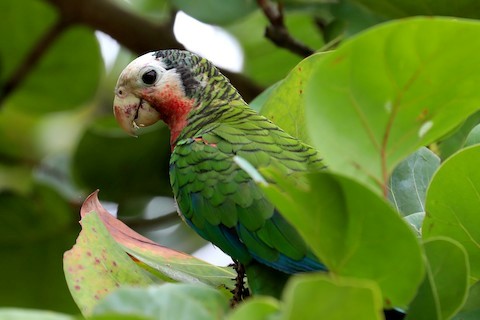Birdfinding.info ⇒ The Bahamian endemic form of Rose-throated Parrot remains fairly common on central and southern Abaco, where it can be seen around Marsh Harbour, Bahama Palm Shores, Sandy Point, and Abaco National Park. Also readily found on Great Inagua, including Matthew Town. The small New Providence flock is seen mostly from downtown Nassau east to Montagu Bay.
“Bahama Parrot”
Amazona leucocephala bahamensis
Endemic to the Bahamas, but limited to Abaco and Inagua. Formerly resident on other major islands of the Bahamas—most recently Acklin, but not since the early 1900s.
A small flock that appeared on New Providence in the early 2000s may be either introduced or conceivably a natural recolonization from Abaco.
In 2016 the Abaco population was estimated at 3,000 to 5,000, and the Inagua population 8,000 to 13,000. The flock on New Providence numbered about 12.
Identification
The only wild parrot in the Bahamas. Its most prominent features include a white forecrown and face, pale bill, and pink bib that extends from the cheeks and throat down onto the chest (and irregularly down to the belly).
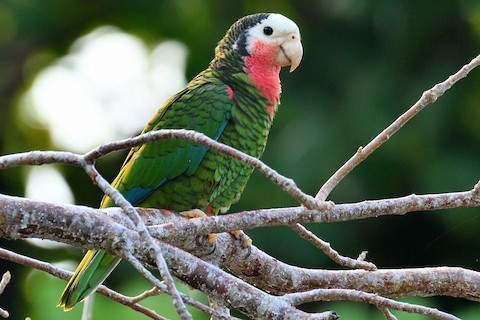
“Bahama Parrot”, A. l. bahamensis. (Bahama Palm Shores, Abaco, Bahamas; April 18, 2021.) © John Doty
The head, neck, back, and chest have a dark, scaly appearance because the feathers are partly green with variably broad blackish tips, typically darkest around the ear.
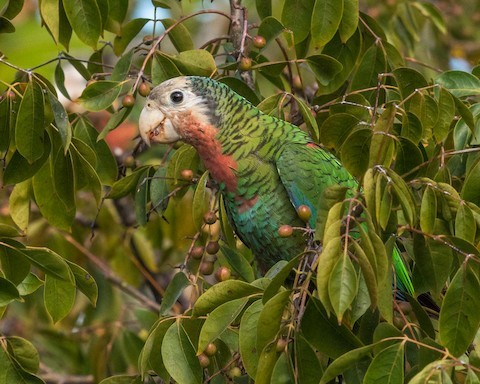
“Bahama Parrot”, A. l. bahamensis. (Marsh Harbour, Abaco, Bahamas; March 4, 2019.) © Sally Chisholm

“Bahama Parrot”, A. l. bahamensis, with atypically extensive pink or reddish feathering on the underparts. (Matthew Town, Great Inagua, Bahamas; March 31, 2018.) © Tarra Lindo
The upperside of the wing is mostly bluish. The underside usually appears mostly green with a black tip and trailing edge.
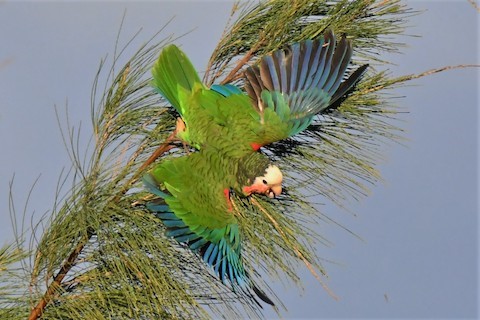
“Bahama Parrot”, A. l. bahamensis, taking flight and showing largely blue wings. (Cherokee, Abaco, Bahamas; January 6, 2018.) © Christopher Johnson
Voice. Many of its vocalizations have a squeaky quality:
Notes
Monotypic form, one of three potentially distinct forms of Rose-throated Parrot (leucocephala).
IUCN Red List Status: Near Threatened.
See below for a comparison of the “Bahama Parrot” with the “Cuban” and “Cayman” Parrots.
Cf. “Cuban” and “Cayman” Parrots. The “Cuban”, “Bahama”, and “Cayman” Parrots are traditionally classified as forms of a single species, which may be appropriate, but their taxonomic status is not definitively settled. Although they do not occur together naturally, vagrancy or transport of captive individuals could take them out of their expected ranges and cause confusion. “Cuban” and “Bahama” both differ from “Cayman” in having far more extensive white on the head and more extensive and contiguous pink on the face, throat, and chest. “Cuban” and “Bahama” differ from one another mainly in the coloration of the belly: green on “Bahama” versus maroon on many “Cubans”. As on “Cuban”, the “Cayman Parrot” often shows extensive maroon on the belly.
More Images of the “Bahama Parrot”

“Bahama Parrot”, A. l. bahamensis. (Abaco, Bahamas; April 16, 2017.) © Mark Van Beirs
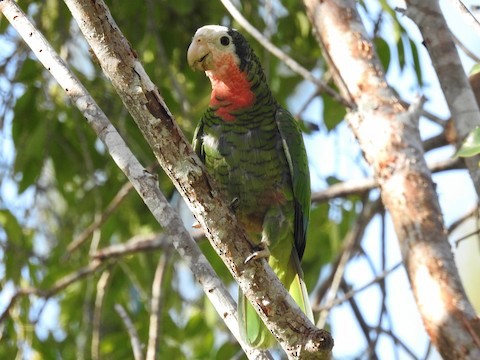
“Bahama Parrot”, A. l. bahamensis. (Bahama Palm Shores, Abaco, Bahamas; April 6, 2019.) © Erika Gates
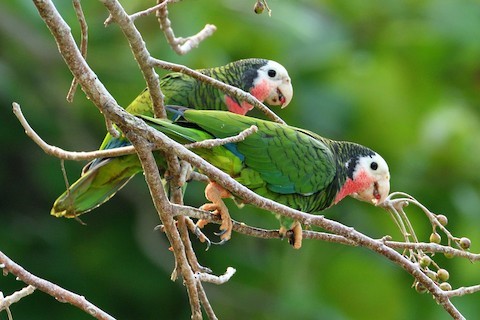
“Bahama Parrot”, A. l. bahamensis. (Bahama Palm Shores, Abaco, Bahamas; April 18, 2021.) © John Doty

“Bahama Parrot”, A. l. bahamensis, with isolated reddish feathers on the belly. (Bahama Palm Shores, Abaco, Bahamas; January 8, 2013.) © Christoph Moning
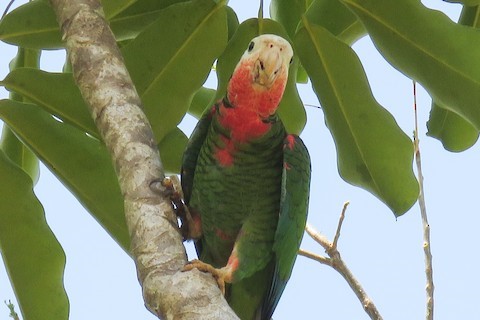
“Bahama Parrot”, A. l. bahamensis. (Bahama Palm Shores, Abaco, Bahamas; May 4, 2019.) © Becky Marvil
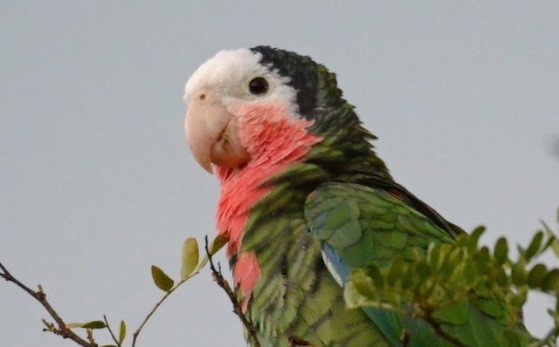
“Bahama Parrot”, A. l. bahamensis. (Bahama Palm Shores, Abaco, Bahamas; April 9, 2017.) © Duncan Mullis
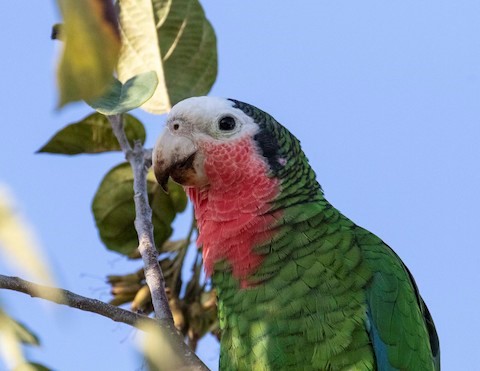
“Bahama Parrot”, A. l. bahamensis. (Matthew Town, Great Inagua, Bahamas; February 26, 2020.) © Kamella Boulle
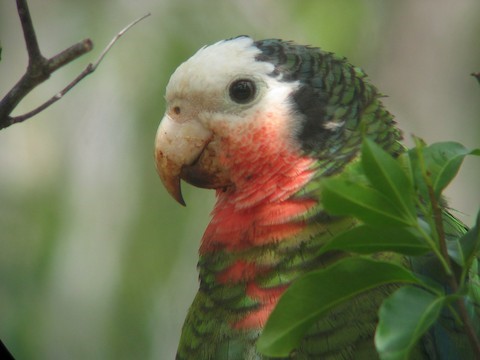
“Bahama Parrot”, A. l. bahamensis. (South Abaco, Bahamas; February 24, 2005.) © Kerry Ross
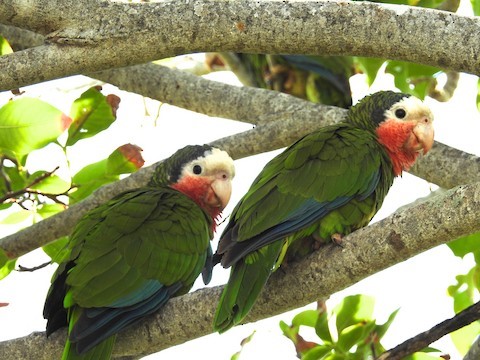
“Bahama Parrot”, A. l. bahamensis. (Salt Pond Hill, Great Inagua, Bahamas; March 10, 2017.) © Erika Gates
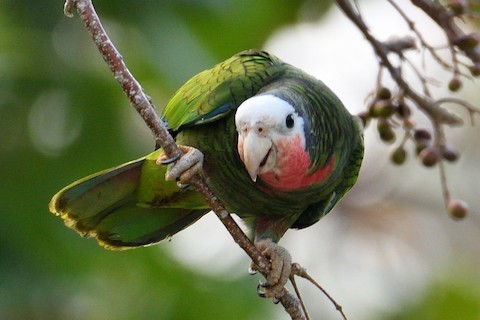
“Bahama Parrot”, A. l. bahamensis. (Bahama Palm Shores, Abaco, Bahamas; April 18, 2021.) © John Doty
References
BirdLife International. 2020. Amazona leucocephala. The IUCN Red List of Threatened Species 2020: e.T22686201A179212864. https://dx.doi.org/10.2305/IUCN.UK.2020-3.RLTS.T22686201A179212864.en. (Accessed January 29, 2022.)
Bond, J. 1979. Birds of the West Indies (Fourth Edition). Collins, London.
eBird. 2022. eBird: An online database of bird distribution and abundance. Cornell Lab of Ornithology, Ithaca, N.Y. http://www.ebird.org. (Accessed January 29, 2022.)
Forshaw, J.M. 2010. Parrots of the World. Princeton University Press, Princeton, N.J.
Juniper, T., and M. Parr. 1998. Parrots: A Guide to Parrots of the World. Yale University Press.
Kirwan, G.M., A. Levesque, M. Oberle, and C.J. Sharpe. 2019. Birds of the West Indies. Lynx Edicions, Barcelona.
Raffaele, H., J. Wiley, O. Garrido, A. Keith, and J. Raffaele. 1998. A Guide to the Birds of the West Indies. Princeton University Press.
Xeno-Canto. 2022. Cuban Amazon – Amazona leucocephala. https://xeno-canto.org/species/Amazona-leucocephala. (Accessed January 29, 2022.)
